When the first diamond frame bicycles became popular in the 1890s they were often called "wheels" - the national cycling association was called the "League of American Wheelmen." We have moved from "wheels" to "bikes," but the bicycles have remained remarkably the same over more than 100 years - elegant in their efficiency and simplicity. And many of the issues that we think are new? They were around then too.
Showing posts with label photos. Show all posts
Showing posts with label photos. Show all posts
Saturday, November 8, 2014
A "Sociable Bicycle" from 1892 in 1922
Human interest photo from Washington Times issue, April 21 1922
This sort of bicycle was introduced in the 1890s as a way of resolving various issues likely perceived with men and women sharing conventional tandems - basically, shouldn't the woman ride in front? One attempt to deal with this was to rig up handlebars for the rider in back that also controlled the steering. Anyway, the Punnett "companion side-seated bicycle" was an attempt to solve the problem by putting the riders on a single two-wheel frame bicycle next to each other.
This bicycle never caught on, of course, presumably because of the manufacturing cost combined with the dexterity to ride it (or perhaps just the appearance that dexterity would be required?) and the relative simplicity of a more standard tandem, despite the "who sits in front" issue.
Thus in the 1920s this bicycle would be featured as a human interest item - although I think the Washington Times got the date wrong; I think these bicycles were introduced only in 1896, not 1892.
Ad for side-by-side Punnett tandem shown from 1896
Despite ads in publications and articles written about this clever bicycle, it never caught on.
One comment - the age of the bike isn't that big a deal, at least not for a well-maintained bicycle.
Thirty year-old bicycle that I ride much of the time to and from work
Saturday, November 1, 2014
1922 Department of Agriculture Police Officer Rides a Bike
The 82 year old cycling policeman - it keeps him young?
The Washington Evening Star., August 13, 1922 has a human interest photo item about a police officer with the Department of Agriculture who rides a bike at work. And not only that, he is 82 years old and has worked for 59 years, under eight different secretaries of Agriculture.
At this distance in time, it is hard to know which of the various elements mentioned would have been considered the most unusual. That he rides a bike at 82? Or that he has worked for almost 60 years, and at that as a policeman? Or perhaps it is all of together.
The Library of Congress has the digitized negative from which the newspaper photograph was made!
In an earlier blog post I discovered a news story photograph from a DC newspaper issue from 1922 that I then serendipitously located the original of in the Prints & Photographs Online Catalog. With no particular hope of success, I searched for "Richard Cook" and I immediately found the same photo of him on his bicycle! Amazing! I was intrigued to see that unlike the previous example that was a Copyright deposit at the time (roughly) the photograph was taken, this was from a photographic collection that came to the Library in the 1940s as a gift. Well, whatever builds the collections - it's all good.
Title: Richard H. Cook, 7/29/22
Date Created/Published: [19]22 July 29.
Medium: 1 negative : glass ; 5 x 7 in. or smaller
Reproduction Number: LC-DIG-npcc-23223 (digital file from original)
Rights Advisory: No known restrictions on publication.
Call Number: LC-F81- 19996 [P&P]
Repository: Library of Congress Prints and Photographs Division Washington, D.C. 20540 USA
Notes:
* Title from unverified data provided by the National Photo Company on the negative or negative sleeve.
* Gift; Herbert A. French; 1947.
* This glass negative might show streaks and other blemishes resulting from a natural deterioration in the original coatings.
[Or it might, in this case, show a big fingerprint from poor handling, but presumably (really) not by anyone at LC . . . ]
* Temp. note: Batch five.
[A "temp"orary note that will be in this record for the remaining time this record is online, however long that might be.]
One small complaint-like comment is that there is no subject heading-like or other mention in the PPOC record of "bicycle." That is, the simplest keyword search for bicycle will not include this photo in the results. I guess that makes finding it that much more delicious.
Detailed view of the photo
I produced the above JPEG by cropping in the downloadable TIFF image - there is a lot of detail available; if you zoom in further you can almost make out details of his police badge. You can see that there is a ring on the front wheel, presumably that has teeth, that connects with a cable that goes up to a handlebars - presumably this was at least provided an odometer function and likely also a speedometer, although there would be no obvious reason for him to track his speed! But it could have been that he was obligated to cover a certain distance on each work shift and this was a way of tracking that. It is a little overbuilt for that function since even in the 1890s odometers were available of a much simpler (and smaller) design - but this would have the information much more readily available while riding.
I was a bit puzzled by where this might be. At first I thought it was near the Smithsonian Castle on Independence Avenue, but I think it is up next to the Botanic Garden (also on Independence) and the smokestack behind is the Capitol Heating Plant.
Saturday, October 25, 2014
1922 DC News Photo - Cyclist Listening to Radio on Bicycle
Fifteen year old DC cyclist has radio mounted on his bike
This comes from the Washington Times for September 4, 1922 - a page titled "Times picture page of live views and news." ("Live" is a relative term, it seems.) The page has a variety of human interest photographs with short explanatory captions.
The quality of the photo reflects that this image was digitized from microfilm that was never expected to serve as the source material for high resolution examination in this way. (Gee, I sound sorta like Nicholson Baker, God help us.)
Anyway, upon thoughtful examination of the image above (or you can zoom in with the PDF version) you can make out that young Murray has a radio fitted in the front triangle of the frame of the bicycle and a set of headphones connected to it by a long-ish cable. Just looking at the photo, the idea of someone riding a bicycle and listening to a radio in 1922 seems advanced but it appears that is not was going on - the caption notes that he "has a fully equipped radio outfit on his two-wheeler and wherever he parks he can cut in on the music." So he was only using this set up when stopped. (Considering that a radio at this time would have had glass tubes, the quality of the streets may have been better in those days.)
According to Wikipedia, radios were not commercially available for cars until the 1930s although hobbyists much like Murray with his bicycle were installing them in cars long before that. But this would have made the idea of a radio for a bicycle - even a parked bicycle - a human interest news item of local DC interest in 1922.
Wednesday, August 13, 2014
Loop-the-Loop Images - Finding Them
The Library of Congress Prints and Photographs Blog has a blog post that includes a digitized photograph of a cyclist performing a loop-the-loop on a bicycle in 1905. I had a blog post of my own describing the same thing, looking at images from Chronicling America (digitized newspapers) from 1902. I thought if these images were online I would have seen them, but apparently not.
Title: [Diavolo performing his bicycle daredevil act before a large audience]
Creator(s): Mathiessen, G. Fred, photographer
Date Created/Published: c1905.
Medium: 1 photographic print.
Summary: Photograph shows a large crowd watching a man riding a bicycle upside down doing a loop and topsy turvy somersault.
http://www.loc.gov/pictures/item/2011660995/
Title: The Loop
Date Created/Published: c1903.
Medium: 1 photographic print.
Summary: Man riding bicycle around loop, at circus.
Reproduction Number: LC-USZ62-58887 (b&w film copy neg.)
Library of Congress
http://www.loc.gov/pictures/item/2005693259/
Title: Looping the Loop
Date Created/Published: c1903.
Medium: 1 photographic print.
Summary: Person going around large upright loop on bicycle.
Reproduction Number: LC-USZ62-89003 (b&w film copy neg.)
Library of Congress
http://www.loc.gov/pictures/item/2002718388/
Title: [Diavolo performing his bicycle daredevil act before a large audience]
Creator(s): Mathiessen, G. Fred, photographer
Date Created/Published: c1905.
Medium: 1 photographic print.
Summary: Photograph shows a large crowd watching a man riding a bicycle upside down doing a loop and topsy turvy somersault.
http://www.loc.gov/pictures/item/2011660995/
Title: The Loop
Date Created/Published: c1903.
Medium: 1 photographic print.
Summary: Man riding bicycle around loop, at circus.
Reproduction Number: LC-USZ62-58887 (b&w film copy neg.)
Library of Congress
http://www.loc.gov/pictures/item/2005693259/
Title: Looping the Loop
Date Created/Published: c1903.
Medium: 1 photographic print.
Summary: Person going around large upright loop on bicycle.
Reproduction Number: LC-USZ62-89003 (b&w film copy neg.)
Library of Congress
http://www.loc.gov/pictures/item/2002718388/
Saturday, April 26, 2014
Striking Workers With Bicycles - 1916 Photograph
Sometimes it takes a little looking, and zooming in, to find photographs from 100 years ago (or so) of bicycles and cyclists.
Bain Collection photograph from Library of Congress of striking workers "on parade"
Detail from above photograph showing bicycles and cyclists in parade on this July day in 1916
A helpful Flickr user clarifies:
There is another (similar) photo in The evening world., July 08, 1916, Final Edition, Image 1 with the following text: "The picture shows the striking cloak and suit makers lined up before office of the Joint board, Cloak and Suit Makers' Union at No. 34 East Twenty-first Street, to draw their weekly allowance of $2 each. The line, four deep, reached down to Fourth Avenue and around into Twentieth Street. About $80,000 is paid to the strikers each week by the board." (http://chroniclingamerica.loc.gov/lccn/sn83030193/1916-07-08/ed-1/seq-1/)
Bain Collection photograph from Library of Congress of striking workers "on parade"
Catalog record:The catalog record does not indicate the inclusion in this photograph of cyclists, who are at left.
Title - Cloak Makers Parade, 1916
Creator(s) - Bain News Service, publisher
Date Created/Published - 1916.
Medium - 1 negative : glass ; 5 x 7 in. or smaller.
Reproduction Number - LC-DIG-ggbain-22182 (digital file from original negative)
Call Number: LC-B2- 3907-14 [P&P]
Repository: Library of Congress Prints and Photographs Division Washington, D.C. 20540 USA http://hdl.loc.gov/loc.pnp/pp.print
Detail from above photograph showing bicycles and cyclists in parade on this July day in 1916
A helpful Flickr user clarifies:
There is another (similar) photo in The evening world., July 08, 1916, Final Edition, Image 1 with the following text: "The picture shows the striking cloak and suit makers lined up before office of the Joint board, Cloak and Suit Makers' Union at No. 34 East Twenty-first Street, to draw their weekly allowance of $2 each. The line, four deep, reached down to Fourth Avenue and around into Twentieth Street. About $80,000 is paid to the strikers each week by the board." (http://chroniclingamerica.loc.gov/lccn/sn83030193/1916-07-08/ed-1/seq-1/)
Sunday, March 23, 2014
Arlington County (VA) and Trail Plowing
March 9 I sent the following as an email to the Arlington Bike Coordinator; later I submitted a revised version to the County Board on their website.

Plowed trail near my house - makes a big difference!
This kind of systematic effort to clear trails used by cyclists (and others, of course) following snow storms is new this year in Arlington, and there was enough snowy weather for some experimentation. The first round was to use salt/road treatment type applications on the trails, which isn't great if you want to walk a dog using the trail and also is hard on the bicycle and the surrounding environment since the salt/chemicals aren't confined to the trail (asphalt). Plowing is a lot better, and the County shifted to that, which is great.
Better still would be to have a little less snow.
It appears that over the winter the County decided to switch from salting trails to plowing. (I leave near Rt 7 and Walter Reed and ride down the trail along Walter Reed, then down the trail along Four Mile Run to the Mt Vernon trail and then in to DC that way.)
I am surprised by the timeliness of some of the plowing that happened - in particular, the that runs parallel to Walter Reed between Rt 7 and Arlington Mill Drive was plowed recently very quickly after the snow - this makes a lot of sense since if you are going to plow trails (and not salt), it should happen fast before the snow turns into ice from people walking on it.
The different this past week was very noticeable between the trails I use in Arlington and the Mt Vernon Trail, which was untreated and unplowed. The main thing was that the trails that were plowed become clear and useable by a regular bike quickly and the Mt Vernon trail was only rideable until Thursday either by riding very carefully or by having a bike with studded tires (which I have).
Plowing isn't a perfect solution - Tuesday in particular some trails had been plowed before my morning ride but the result was that the asphalt (with the 15 degree weather) was coated with a thin sheet of ice instead of a thicker layer of ice and snow so that a regular bike would not have traction - it would have been impossible to ride without studded tires. But by that afternoon the situation was already better, and Wednesday morning the Arlington trails were rideable (with care) while the Mt Vernon trail was not. Still, I think plowing is better than treating with salt etc.
The plowing is good. Thank you.

Plowed trail near my house - makes a big difference!
This kind of systematic effort to clear trails used by cyclists (and others, of course) following snow storms is new this year in Arlington, and there was enough snowy weather for some experimentation. The first round was to use salt/road treatment type applications on the trails, which isn't great if you want to walk a dog using the trail and also is hard on the bicycle and the surrounding environment since the salt/chemicals aren't confined to the trail (asphalt). Plowing is a lot better, and the County shifted to that, which is great.
Better still would be to have a little less snow.
Saturday, March 8, 2014
Cycle Chic by Mikael Colville-Andersen (Book Review)
 Cycle Chic by Mikael Colville-Andersen
Cycle Chic by Mikael Colville-AndersenMy rating: 5 of 5 stars
First - my five stars is because as I understand Goodreads, the idea for assigning stars is did I like the book and not is it a good book generally.
This a book of photographs with very little text, loosely organized thematically, from Mikael Colville-Andersen, the Copenhagen-based creator of the blog Copenhagen Cycle Chic.
The photographs are about the people in them and the bicycles they are with together, in support of the "Cycle Chic Manifesto". This manifesto declares things like, "I choose to cycle chic and, at every opportunity, I will choose Style over Speed" or "I will endeavour to ensure that the total value of my clothes always exceeds that of my bicycle" and "I will refrain from wearing and owning any form of 'cycle wear'."
The book includes hundreds of color photographs (and a very small number of B&W) taken all over the world, but predominately in Europe, in particular in Copenhagen. Most but not all were taken by Colville-Andersen and most appear unposed.
The role that such a (physical) book plays in our world today is an interesting (perhaps) question - one can see many of the kinds of photographs included in the book in the Copenhagen Cycle Chic blog (or many of the similar blogs that Cycle Chic provides links to). One can also see
Colville-Andersen's photos in his Flickr account (although there are plenty of non-bicycle photos there, too). I don't have an answer to this question - in this particular case, the book seems pleasing because it emphasizes the photographs one-by-one in a way that neither Flickr nor the blog presentations do, and allows for flipping around that the Internet still doesn't support.
Fun. Good.
View all my reviews of cycling books on Goodreads.
Saturday, January 4, 2014
DC Bike Messengers 100 Years Ago - 1912
In a blog post a few days ago, about some bicycle accidents in 1913 in Washington DC, I included a photograph of a bicycle messenger (below) - I have since looked to see how many other photos of DC messengers were digitized and available on the Library of Congress Prints & Photographs Catalog - it seems there are just two more.
Title: Sam Maddox, 132 N St., S.E., Washington, D.C. Western Union No. 227, one of the young boys pretty close to the age limit. Was born Oct. 3, 1898, which makes him 13 yrs. old. Has permit to work from Juvenile Court. Has been troublesome in school. Location: Washington (D.C.), District of Columbia.Lewis Hine was a photographer (among other things) whose photographs were important in getting child labor laws passed - many of his collection items have been digitized by the Library of Congress, including photographs of bicycle messengers from different parts of the U.S. Of which there are three from Washington DC.
Creator(s): Hine, Lewis Wickes, 1874-1940, photographer
Date Created/Published: [1912 April]
Medium: 1 photographic print.
Reproduction Number: LC-DIG-nclc-03766 (color digital file from b&w original print)
Library of Congress
www.loc.gov/pictures/item/ncl2004000319/PP/
Title: Earle Griffith and Eddie Tahoory, working for the Dime Messenger Service. They said they never knew when they were going to get home at night. Usually work one or more nights a week, and have worked until after midnight. They said last Christmas their office had a 9 yr. old boy running errands for them, and that he made a great deal of money from tips. They make about $7 a week and more, sometimes. Said "The office is not allowed to send us into the red light district but we go when a call sends us. Not very often." Location: [Washington (D.C.), District of Columbia].Apparently one concern was that bicycle messengers were often assigned to make deliveries in "red light districts." (The "titles" for these items are taken from the annotations from the collection and are interesting.)
Creator(s): Hine, Lewis Wickes, 1874-1940, photographer
Date Created/Published: 1912 April.
Medium: 1 photographic print.
Reproduction Number: LC-DIG-nclc-03757 (color digital file from b&w original print)
Library of Congress
www.loc.gov/pictures/item/ncl2004002434/PP/
Title: Wilbur H. Woodward, 428 Third St., N.W., Washington, D.C., Western Union messenger 236, one of the youngsters on the border-line, (15 yrs. old) works until 8 P.M. only. Location: Washington (D.C.), District of Columbia.If you follow the links to the LC presentations of these items, they have different versions that were digitized from the glass plate negatives that are (in effect) B&W rather than these digitized prints, which are "in color" in the sense that they reflect the way that the prints look now (i.e., sort of sepia toned). I prefer the digitized prints, but others might prefer the digitized negatives. Something for everyone ~
Creator(s): Hine, Lewis Wickes, 1874-1940, photographer
Date Created/Published: 1912 April.
Medium: 1 photographic print.
1 negative : glass ; 5 x 7 in.
Reproduction Number: LC-DIG-nclc-03761 (color digital file from b&w original print)
Library of Congress
www.loc.gov/pictures/item/ncl2004000314/PP/
Friday, January 3, 2014
1914 - The Year World War I Started
Later in 1914 we will have the 100th anniversary of the start of World War I, about which I expect we'll read and hear plenty. Bicycles were a relatively low-cost way to achieve a more mobile infantryman, but their use seems to have been limited. Still, one does see photographs.
France - Cyclists of Army, from the Library of Congress
[between ca. 1914 and ca. 1915]
1 negative : glass ; 5 x 7 in. or smaller.
Notes: Title from data provided by the Bain News Service on the negative.
Photograph shows French soldiers with bicycles during the beginning of World War I.
Forms part of: George Grantham Bain Collection (Library of Congress).
Subjects-World War, 1914-1918.
Bain News Service Collection
http://hdl.loc.gov/loc.pnp/ggbain.17027 persistent URL for version at Library of Congress.
While cyclist-soldiers take up most of the visual space in the photograph above, there is one mounted cavalryman to the left. One wonders how the two groups, cyclists and traditional cavalry, regarded one another.
Cycle orderlies under fire, from the National Library of Scotland
From the National Library of Scotland description of this photograph: Cyclists sheltering from shelling, Western Front, during World War I. A shell bursting in the rubble of ruined buildings beside a road. Two cyclists have turned their bikes upside down and are using the wheels to give a little shelter from the blast. Curiously, a third man, appearing totally unconcerned, seems to be using a hammer and chisel on a rock in the road.
Bicycles were used quite commonly, not only for general transport, but also for carrying dispatches. Motorbikes, runners, pigeons and dogs were also used to carry messages because field telephones were limited by the need for cables and wireless was still unreliable.
I think the person who wrote this annotation is lacking imagination - rather than using a hammer and a chisel on a rock, I believe the fellow is bashing some bicycle part to try to bend it - that would make more sense. I also don't think they were seeking shelter behind their bicycles - not much shelter to be had! It seems more logical that they were simply working on their bikes, the photographer was going to record that scene, and by chance the photographer captured the shell going off in the background as well. Anyway, I like that theory better.
By chance I found this book written by a young American journalist, Roadside Glimpses of the Great War by Arthur Sweetser, published in 1916 before the United States was part of WWI - amazingly he did much of his travel in the war zones of France and Belgium by bicycle. On page 23 he starts what is probably one of the more unusual bicycle travelogues:
France - Cyclists of Army, from the Library of Congress
[between ca. 1914 and ca. 1915]
1 negative : glass ; 5 x 7 in. or smaller.
Notes: Title from data provided by the Bain News Service on the negative.
Photograph shows French soldiers with bicycles during the beginning of World War I.
Forms part of: George Grantham Bain Collection (Library of Congress).
Subjects-World War, 1914-1918.
Bain News Service Collection
http://hdl.loc.gov/loc.pnp/ggbain.17027 persistent URL for version at Library of Congress.
While cyclist-soldiers take up most of the visual space in the photograph above, there is one mounted cavalryman to the left. One wonders how the two groups, cyclists and traditional cavalry, regarded one another.
Cycle orderlies under fire, from the National Library of Scotland
From the National Library of Scotland description of this photograph: Cyclists sheltering from shelling, Western Front, during World War I. A shell bursting in the rubble of ruined buildings beside a road. Two cyclists have turned their bikes upside down and are using the wheels to give a little shelter from the blast. Curiously, a third man, appearing totally unconcerned, seems to be using a hammer and chisel on a rock in the road.
Bicycles were used quite commonly, not only for general transport, but also for carrying dispatches. Motorbikes, runners, pigeons and dogs were also used to carry messages because field telephones were limited by the need for cables and wireless was still unreliable.
I think the person who wrote this annotation is lacking imagination - rather than using a hammer and a chisel on a rock, I believe the fellow is bashing some bicycle part to try to bend it - that would make more sense. I also don't think they were seeking shelter behind their bicycles - not much shelter to be had! It seems more logical that they were simply working on their bikes, the photographer was going to record that scene, and by chance the photographer captured the shell going off in the background as well. Anyway, I like that theory better.
By chance I found this book written by a young American journalist, Roadside Glimpses of the Great War by Arthur Sweetser, published in 1916 before the United States was part of WWI - amazingly he did much of his travel in the war zones of France and Belgium by bicycle. On page 23 he starts what is probably one of the more unusual bicycle travelogues:
It was obvious that even if the Germans entered Lille at all, it would be only with a small holding force. The main army was driving through farther east. Douai, they told me, was the centre of activities, but how to cover the forty kilometres there was a poser. At last the idea of a bicycle struck me. It would be quaint indeed thus to chase the battle-front blindly all over France. After a whole day's hunting and tremendous linguistic effort, I secured the best the city could offer, the best bicycle, I soon believed, in all France, a machine which, costing me but $23 secondhand, was destined to take me half across the country.
Saturday, November 30, 2013
Lance Armstrong in the Public Domain & Other Finds in "The Commons"
The Flickr Commons has many interesting digitized historical photographs of cycling and also the (very) occasional original "born digital" photograph as well - these are believed to be in the public domain or otherwise under some Creative Commons type license and available for use in things like my blog. So occasionally I go through the search results in the Flickr Commons for "bicycle" just to see what is there. Since the search results include items in Flickr where users have added tags, the available search terms are often more than if one did searching in the "native" system. So for example, a user may tag a photo from the Library of Congress with a bicycle in the background with the word "bicycle" when the Library of Congress would not have that as a search term associated with that photograph.
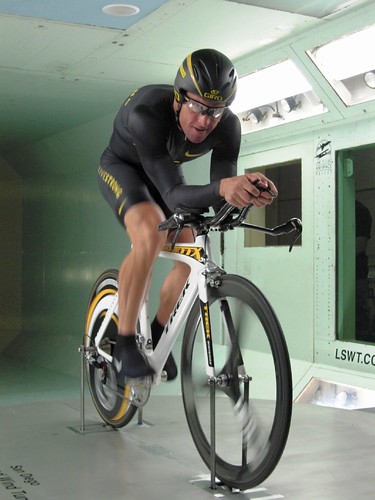
A digital photo (not digitized) of Lance A from the San Diego Air & Space Museum Archives
The San Diego Air & Space Museum Archives has an unusually large number of photographs, both digitized and "born digital," in the Flickr Commons - about 166,000. Among those are a few tagged with "bicycle." The photo above is unusual generally for the Flickr Commons because it is a photograph of a public figure, Lance Armstrong, taken relatively recently (2008), and in the public domain. Or anyway, the statement is that, "there are no known copyright restrictions." Perhaps in their hurry to put material online, the amount of metadata supplied for any item can be minimal - here the title is "wind tunnel (2)" and that's all there is - Lance Armstrong is not named (or searchable).
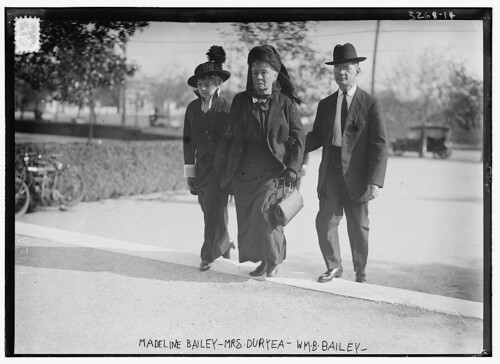
Blurry bicycle in the background, off to the left
Above is an example where the user-added tags include bicycle, resulting in a "hit" for this photograph, although most users will not find this particularly helpful since the bicycle is so blurry as to be unidentifiable other than that it is a bicycle. Although perhaps someone might find useful the presentation of the opportunistic nature of bicycle parking in 1910 (as compared to today).
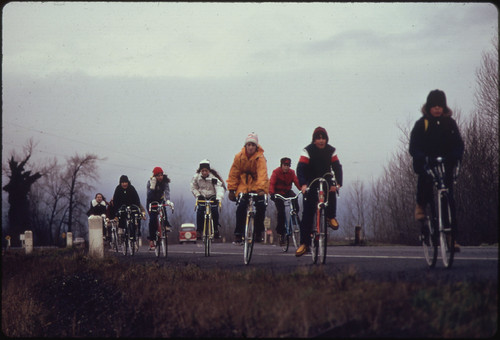
National Archives digitized photograph showing children cycling in Oregon in 1974
The National Archives has some digitized photographs (including a few with bicycles) from after 1923, after which U.S. published materials (well other than music . . .) are generally not in the public domain. I am particularly amused by some photographs that document life during the "gas crisis" of the 1970s. The caption for the above photo states that, "School Children, Were Forced to Use Their Bicycles on Field Trips During the Fuel Crisis in the Winter of 1974. There Was Not Enough Gasoline for School Buses to Be Used for Extracurricular Activities, Even During Dark and Rainy Weather 02/1974." Apparently (and perhaps not surprisingly) things were more dire in Oregon in this regard than they were in Washington DC - I don't remember this level of deprivation around here. The children depicted all seem to have road bikes - was that typical in Oregon? It sure wasn't here. That I recall.

A digital photo (not digitized) of Lance A from the San Diego Air & Space Museum Archives
The San Diego Air & Space Museum Archives has an unusually large number of photographs, both digitized and "born digital," in the Flickr Commons - about 166,000. Among those are a few tagged with "bicycle." The photo above is unusual generally for the Flickr Commons because it is a photograph of a public figure, Lance Armstrong, taken relatively recently (2008), and in the public domain. Or anyway, the statement is that, "there are no known copyright restrictions." Perhaps in their hurry to put material online, the amount of metadata supplied for any item can be minimal - here the title is "wind tunnel (2)" and that's all there is - Lance Armstrong is not named (or searchable).

Blurry bicycle in the background, off to the left
Above is an example where the user-added tags include bicycle, resulting in a "hit" for this photograph, although most users will not find this particularly helpful since the bicycle is so blurry as to be unidentifiable other than that it is a bicycle. Although perhaps someone might find useful the presentation of the opportunistic nature of bicycle parking in 1910 (as compared to today).

National Archives digitized photograph showing children cycling in Oregon in 1974
The National Archives has some digitized photographs (including a few with bicycles) from after 1923, after which U.S. published materials (well other than music . . .) are generally not in the public domain. I am particularly amused by some photographs that document life during the "gas crisis" of the 1970s. The caption for the above photo states that, "School Children, Were Forced to Use Their Bicycles on Field Trips During the Fuel Crisis in the Winter of 1974. There Was Not Enough Gasoline for School Buses to Be Used for Extracurricular Activities, Even During Dark and Rainy Weather 02/1974." Apparently (and perhaps not surprisingly) things were more dire in Oregon in this regard than they were in Washington DC - I don't remember this level of deprivation around here. The children depicted all seem to have road bikes - was that typical in Oregon? It sure wasn't here. That I recall.
Wednesday, October 9, 2013
Who's Buried in Grant's Tomb?
So here is an item from the Library of Congress with more quite a lot of metadata, but somehow I had not noticed it while searching for "bicycles" but found it while searching for "cycling" - the title is "cycling" so it came right up. (I confess, as photographs go, it isn't much . . . ) If I understand the "summary" correctly, this item is likely a posed photograph in order to create the cover of some sheet music.
Alas despite all this metadata, one searchable term is misspelled - "tandem" bicycle is rendered as "tanden bicycle" - when (or it feels like, if) I get back to working I will suggest it is corrected. (Somewhat to my surprise, we have a photograph of Danny Kaye riding a tandem bicycle from 1958 available publicly. Anyway, a search on loc.gov of "tandem bicycle" does bring up results, just not this one.) The digitized item showing a couple riding in front of Grant's tomb was made from a copy negative - that is, it is a copy of a copy - which explains some, but I suspect not all, of why it isn't a digital image showing much detail.)

Riding in front of Grant's tomb
Title Cycling
Creator(s) Scott & Van Altena, copyright claimant
Date Created/Published c1907.
Medium 1 photographic print.
Summary Lantern slide proof print, probably for a song. Photograph shows a smiling young couple on the road riding a tanden bicycle near Grant's Tomb in New York City; the young woman at the front looks partially back towards the man.
Reproduction Number LC-USZ62-21830 (b&w film copy neg.)
Rights Advisory No known restrictions on publication.
Call Number SSF - Bicycles and Tricycles [item] [P&P]
Repository Library of Congress Prints and Photographs Division Washington, D.C. 20540 USA http://hdl.loc.gov/loc.pnp/pp.print
Notes
* No. 10.
* Copyright by Scott & Van Altena, New York, N. Y.
* Title from item.
Subjects
-Bicycles & tricycles--New York (State)--New York--1900-1910.
-Cyclists--New York (State)--New York--1900-1910.
-Cycling--New York (State)--New York--1900-1910.
-Tombs & sepulchral monuments--New York (State)--New York--1900-1910.
-General Grant National Memorial (New York, N.Y.)
Format
-Lantern slides--Reproductions--1900-1910.
-Photographic prints--1900-1910.
Collections Miscellaneous Items in High Demand
Bookmark This Record: http://www.loc.gov/pictures/item/2011661553/
Alas despite all this metadata, one searchable term is misspelled - "tandem" bicycle is rendered as "tanden bicycle" - when (or it feels like, if) I get back to working I will suggest it is corrected. (Somewhat to my surprise, we have a photograph of Danny Kaye riding a tandem bicycle from 1958 available publicly. Anyway, a search on loc.gov of "tandem bicycle" does bring up results, just not this one.) The digitized item showing a couple riding in front of Grant's tomb was made from a copy negative - that is, it is a copy of a copy - which explains some, but I suspect not all, of why it isn't a digital image showing much detail.)

Riding in front of Grant's tomb
Title Cycling
Creator(s) Scott & Van Altena, copyright claimant
Date Created/Published c1907.
Medium 1 photographic print.
Summary Lantern slide proof print, probably for a song. Photograph shows a smiling young couple on the road riding a tanden bicycle near Grant's Tomb in New York City; the young woman at the front looks partially back towards the man.
Reproduction Number LC-USZ62-21830 (b&w film copy neg.)
Rights Advisory No known restrictions on publication.
Call Number SSF - Bicycles and Tricycles [item] [P&P]
Repository Library of Congress Prints and Photographs Division Washington, D.C. 20540 USA http://hdl.loc.gov/loc.pnp/pp.print
Notes
* No. 10.
* Copyright by Scott & Van Altena, New York, N. Y.
* Title from item.
Subjects
-Bicycles & tricycles--New York (State)--New York--1900-1910.
-Cyclists--New York (State)--New York--1900-1910.
-Cycling--New York (State)--New York--1900-1910.
-Tombs & sepulchral monuments--New York (State)--New York--1900-1910.
-General Grant National Memorial (New York, N.Y.)
Format
-Lantern slides--Reproductions--1900-1910.
-Photographic prints--1900-1910.
Collections Miscellaneous Items in High Demand
Bookmark This Record: http://www.loc.gov/pictures/item/2011661553/
Saturday, September 28, 2013
Russian Boy Madly Cycling, 1977
On my Flickr account where I keep images of cycling from various public domain sources I also have been uploading digitized photos from when I was in Russia, in Leningrad mostly, in the 1970s.
I only seem to have a few that involve bicycles, and all are of children on bikes.

Taken when I was living in then-Leningrad in spring, 1977
This little boy probably wasn't happy that I was taking his picture, so perhaps that explains his rush. This generation of urban Russians probably included many who didn't learn how to ride a bicycle - Russia is a much smaller market for purchase of bicycles than the U.S., even today - something like 4 million bicycles sold in 2012 versus close to 19 million in the U.S. (including kids' bikes). While at first glance it looks like a reasonable little bike, it is actually rather sad - I don't think those can be inflatable tires but are rather solid rubber (or something) so it would be a fairly rough ride. Everything about it looks under-built. On the plus side, it cannot have been particularly heavy, which is the downfall of most modern kids' cheap bikes - overbuilt of cheap heavy metal so that a kid's bike weighs as much as an adult's bike

For Lenin's birthday, Soviets would do a public spring cleaning on one weekend in April
This photo, also taken in 1977, shows two children with what appears to be better bicycles - small wheels but with inflatable tires, at least. (The second one is towards the middle and facing away from the camera.) So perhaps for some "upper middle class Soviet urban folks" (or whatever one would describe them as) of that period, having a bicycle for one's (usually only) child was not unusual.
I only seem to have a few that involve bicycles, and all are of children on bikes.

Taken when I was living in then-Leningrad in spring, 1977
This little boy probably wasn't happy that I was taking his picture, so perhaps that explains his rush. This generation of urban Russians probably included many who didn't learn how to ride a bicycle - Russia is a much smaller market for purchase of bicycles than the U.S., even today - something like 4 million bicycles sold in 2012 versus close to 19 million in the U.S. (including kids' bikes). While at first glance it looks like a reasonable little bike, it is actually rather sad - I don't think those can be inflatable tires but are rather solid rubber (or something) so it would be a fairly rough ride. Everything about it looks under-built. On the plus side, it cannot have been particularly heavy, which is the downfall of most modern kids' cheap bikes - overbuilt of cheap heavy metal so that a kid's bike weighs as much as an adult's bike

For Lenin's birthday, Soviets would do a public spring cleaning on one weekend in April
This photo, also taken in 1977, shows two children with what appears to be better bicycles - small wheels but with inflatable tires, at least. (The second one is towards the middle and facing away from the camera.) So perhaps for some "upper middle class Soviet urban folks" (or whatever one would describe them as) of that period, having a bicycle for one's (usually only) child was not unusual.
Wednesday, September 25, 2013
Stereographs in Twitch Mode - Example
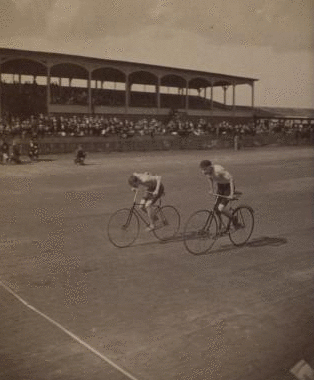
GIF made with the NYPL Labs Stereogranimator
L. A. W., bicycle race, safety, the finish. 1865?-1880? 1890
A little random cycling fun from New York Public Library - for more, look here.
Yikes.
Saturday, September 7, 2013
Human Powered Flying Glider-Bicycle

Pre-WWI French "Aviette", from the Library of Congress
It can be amusing to look through the Flickr Commons doing searches for keywords (like bicycle!) to see what is available. People often add more searchable tags so that photos with bicycles in the background will be part of the search result that otherwise would be missed.

Photo in Flickr Commons identified as having a bicycle in it - but pretty hard to find!
Saturday, July 20, 2013
Bicycles, Motorcycles and Old Photographs

Peirce Mill in Rock Creek Park 1918-1920, two cars, one motorcycle, one bicyclec
From the Library of Congress Prints and Photographs Online Catalog
Title Rock Creek Park
Date Created/Published [between 1918 and 1920]
Medium 1 negative : glass ; 4 x 5 in. or smaller
Reproduction Number LC-DIG-npcc-00028 (digital file from original)
Rights Advisory No known restrictions on publication.
Call Number LC-F8- 1543 [P&P]
Link - http://www.loc.gov/pictures/item/npc2007000025/
Subjects
Pierce Mill (Washington, D.C.)
Bicycles & tricycles.
Automobiles.
Men.
Women.
Water mills.
Rock Creek Park (Washington, D.C.)
United States--District of Columbia--Washington (D.C.)--Rock Creek Park.
While there quite a few subject headings assigned to this photograph, the person who looked at it was not able to distinguish the motorcycle on the left and the bicycle on the right - early motorcycles were much closer to bicycles in appearance, reflecting their direct evolution from bicycles. Also, it seems clear these are police officers - you can see badges on their jackets and they have the right sort of uniform hats. (See the detail photo below.)
Given where Peirce Mill is in Rock Creek Park in Washington DC, one wonders how it happened that the two officers are together with their different modes of transportation. Are they connected with the women and the cars, and the person just visible in the back of one of the cars?
Peirce Mill has not operated commercially for years but apparently still can be operated for demonstration so in a sense is a working mill - it is used for school programs by the National Park Service and is open for visitors. So, the folks in the photo were on an outing? With policy escort? Another mystery of an old photograph.
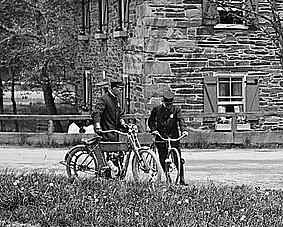
Detail showing the two police officers, one with a motorcycle, one with a bicycle
Oddly the Library of Congress has the Mill's name as "Pierce Mill" but the National Park Service web site makes clear it is "Peirce Mill" - I will have to suggest that it be corrected in the LoC database.
Saturday, July 6, 2013
Laurel MD Race Track Used for Cycle Racing (1925)
Apparently this 1.1 mile track in Laurel Maryland was primarily used for auto racing but was also used for bicycle racing from time to time (in 1925). Here are some photos of the track in both "modes" in 1925.
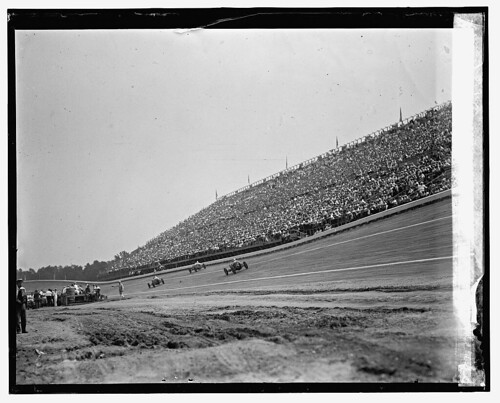
The track on July 11 of 1925 for auto racing
Title: Laurel Race, 7/11/25
Date Created/Published: [19]25 July 11.
Medium: 1 negative : glass ; 4 x 5 in. or smaller
Reproduction Number: LC-DIG-npcc-13958 (digital file from original)
Rights Advisory: No known restrictions on publication.
Call Number: LC-F8- 36387 [P&P]
Library of Congress
www.loc.gov/pictures/item/npc2007013957/

The same wood track being used for a bicycle race a week later
Title: Laurel bicycle races, 7/18/25
Date Created/Published: [19]25 July 18.
Medium: 1 negative : glass ; 4 x 5 in. or smaller
Reproduction Number: LC-DIG-npcc-14017 (digital file from original)
Rights Advisory: No known restrictions on publication.
Call Number: LC-F8- 36590 [P&P]
Library of Congress
www.loc.gov/pictures/item/npc2007014016/
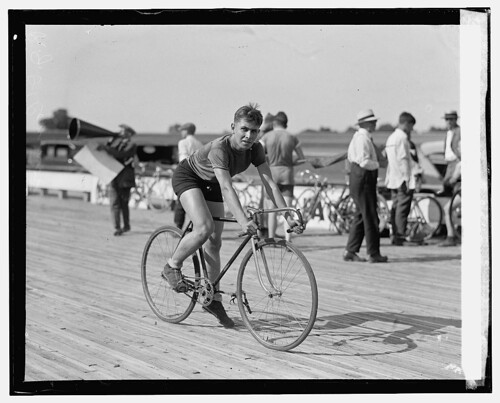
One of the individual racers
Title: R.J. O'Conner, Laurel bicycle races, [7/18/25]
Date Created/Published: [1925 July 18]
Medium: 1 negative : glass ; 4 x 5 in. or smaller
Reproduction Number: LC-DIG-npcc-14014 (digital file from original)
Rights Advisory: No known restrictions on publication.
Call Number: LC-F8- 36587 [P&P]
Library of Congress
www.loc.gov/pictures/item/npc2007014013/
If you Google "laurel race track 1925" you come up with blog posts and various sites selling images, none of which mention that the image comes from the Library of Congress. Peculiar. These are from the National Photo Company Collection at LC, digitized from glass plate negatives.

The track on July 11 of 1925 for auto racing
Title: Laurel Race, 7/11/25
Date Created/Published: [19]25 July 11.
Medium: 1 negative : glass ; 4 x 5 in. or smaller
Reproduction Number: LC-DIG-npcc-13958 (digital file from original)
Rights Advisory: No known restrictions on publication.
Call Number: LC-F8- 36387 [P&P]
Library of Congress
www.loc.gov/pictures/item/npc2007013957/

The same wood track being used for a bicycle race a week later
Title: Laurel bicycle races, 7/18/25
Date Created/Published: [19]25 July 18.
Medium: 1 negative : glass ; 4 x 5 in. or smaller
Reproduction Number: LC-DIG-npcc-14017 (digital file from original)
Rights Advisory: No known restrictions on publication.
Call Number: LC-F8- 36590 [P&P]
Library of Congress
www.loc.gov/pictures/item/npc2007014016/

One of the individual racers
Title: R.J. O'Conner, Laurel bicycle races, [7/18/25]
Date Created/Published: [1925 July 18]
Medium: 1 negative : glass ; 4 x 5 in. or smaller
Reproduction Number: LC-DIG-npcc-14014 (digital file from original)
Rights Advisory: No known restrictions on publication.
Call Number: LC-F8- 36587 [P&P]
Library of Congress
www.loc.gov/pictures/item/npc2007014013/
If you Google "laurel race track 1925" you come up with blog posts and various sites selling images, none of which mention that the image comes from the Library of Congress. Peculiar. These are from the National Photo Company Collection at LC, digitized from glass plate negatives.
Tuesday, May 21, 2013
"Jet Roars over Bicycle Path near Washington's Nation[al] Airport"
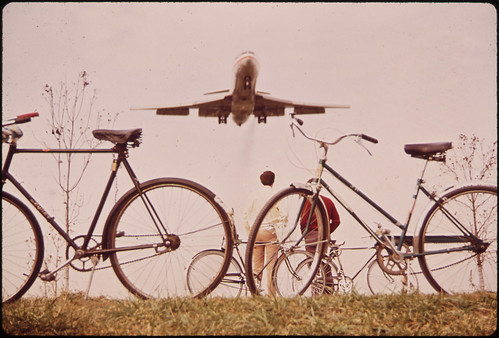
Jet Roars over Bicycle Path near Washington's Nation[al] Airport.
From the National Archives and Records Administration (NARA) "Commons" space on Flickr. Flickr redid their interface overnight and the opening screen features what they call "The Commons" more. I assume that rendering the name of the airport as "Nation Airport" rather than National Airport (now Reagan National Airport) is a typo. ??? It's also slightly odd that the subject heading is for Washington DC without one for Arlington VA. While it is nominally Washington's airport it isn't in Washington.
Original Caption: Jet Roars over Bicycle Path near Washington's Nation Airport. Noise-Decibel Level from Aircraft at This Altitude Can Cause Permanent Ear Damage. 11/1972
U.S. National Archives’ Local Identifier: 412-DA-2470
Photographer: Calonius, Erik
Subjects:
Washington (District of Columbia, United States) inhabited place
Environmental Protection Agency
Project DOCUMERICA
Persistent URL: arcweb.archives.gov/arc/action/ExternalIdSearch?id=544963
Access Restrictions: Unrestricted
Use Restrictions: Unrestricted
~~~~~~~~~~~~~~~~~~~~~~~~~~~~~~~~~~~~~~~
Now the noise level is much lower from jet engines than in 1972. The 727 was known for being particularly noisey. At least there is some progress. . . And one doesn't see 727s any more - not all gone I'm sure but not used here.
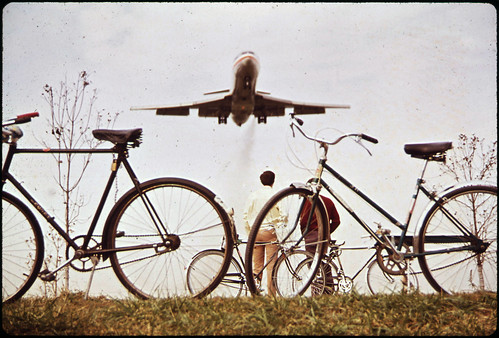
A color corrected version so the sky isn't such an odd color
Tuesday, May 7, 2013
Finding Mrs. L.C. Boardman on Her Bike, 1895

Mrs. L.C. Boardman shown riding a bike, 1895, Library of Congress
Here is the Library of Congress record
Title: [Mrs. L.C. Bordman, full length portrait, on bicycle, facing left; wearing derby hat]
Date Created/Published: c1895.
Medium: 1 photographic print.
Reproduction Number: LC-USZ62-63619 (b&w film copy neg.)
Call Number: LOT 13714, no. 100 (H) [P&P] Oversize Misc.,
I found this item in the Prints and Photographs Online Catalog at the Library of Congress. I go into it from time to time to see if any new (old) bicycle photographs have been added or if I have missed something interesting by not looking close enough in the past.
In examining this photo from 1895 as presented by PPOC I have several comments:
* The person who put this online didn't look at the label on the photograph closely or made a keying error, thus the subject's name is recorded as "Bordman" not "Boardman."
* This digital reproduction was made not from the original print that was deposited at the Library of Congress on Copyright but from a negative that was made in order to satisfy a Photoduplication request some time much later. So this is a copy of a copy, which is one reason it may be somewhat less than sharp (although it is hard to tell).
* The 40 kb JPEG, which for some reason is only available on site at the Library of Congress although it is not really possible for it not to be in the public domain, isn't very good because the quality was greatly reduced in creating an image that loads quickly. Having just one JPEG derivative was more a common practice some years ago but isn't now.
* The TIFF image has some issues with the black areas on her dress, "blocking up," but otherwise the most detailed JPEG in my Flickr set shows details of the bicycle and her cycling attire otherwise. I produced an 850 kb JPEG from the TIFF on the LC site.
I like her derby hat.
Mr. L.C. Boardman, it turns out, was active in the "good roads" movement
Mrs. Boardman may have been photographed in 1895 on a bicycle but after the turn of the century, her husband was apparently active in trying to improve roads for automobiles. In the text above, he is described as giving a lecture to the Automobile Club of America. Oh well. . .
Friday, January 11, 2013
Circuses & Bicycles 1900
Someone at work knows I am interested in historical images of cycling so she emailed me a link the this image in the National Library of Ireland's Flickr area.

Photo from the National Library of Ireland
Title - Mr Minton ? & Mr Lloyds, Circus on spiral rail, circa 1900
Main Author - A. H. Poole Studio Photographer
In Collections - The Poole Photographic Collection
The National Library of Ireland
I have to say, this is not exactly the most impressive feat involving a bicycle, but for a small circus . . . in fact, it would seem like setting up that spiral would have been a lot of work, so one guesses that they did something with it beside have this guy ride the bike up it. And what happens at the top, anyway?
A Library of Congress search for "bicycle" and "circus" brings up mostly posters.

Cropped and rotated image of 1900 circus poster from Library of Congress online presentation
Title: The Adam Forepaugh and Sells Brothers, America's greatest shows consolidated--The miraculous Melrosas
Date Created/Published: Buffalo, N[ew] Y[ork] : Courier Company Lith. Dept., c1900.
Medium: 1 print (poster) : chromolithograph ; 71 x 105 cm.
Summary: Poster showing circus performers riding bicycles on tightropes.
Reproduction Number: LC-USZC4-10501 (color film copy transparency)
Most (if not all) of the LC digitized circus posters are like this one, taken from a color negative that was produced before digitization from the original was more commonplace. I rotated the image (deskewed) and took out the color bars. The LC version is here.

Photo from the National Library of Ireland
Title - Mr Minton ? & Mr Lloyds, Circus on spiral rail, circa 1900
Main Author - A. H. Poole Studio Photographer
In Collections - The Poole Photographic Collection
The National Library of Ireland
I have to say, this is not exactly the most impressive feat involving a bicycle, but for a small circus . . . in fact, it would seem like setting up that spiral would have been a lot of work, so one guesses that they did something with it beside have this guy ride the bike up it. And what happens at the top, anyway?
A Library of Congress search for "bicycle" and "circus" brings up mostly posters.

Cropped and rotated image of 1900 circus poster from Library of Congress online presentation
Title: The Adam Forepaugh and Sells Brothers, America's greatest shows consolidated--The miraculous Melrosas
Date Created/Published: Buffalo, N[ew] Y[ork] : Courier Company Lith. Dept., c1900.
Medium: 1 print (poster) : chromolithograph ; 71 x 105 cm.
Summary: Poster showing circus performers riding bicycles on tightropes.
Reproduction Number: LC-USZC4-10501 (color film copy transparency)
Most (if not all) of the LC digitized circus posters are like this one, taken from a color negative that was produced before digitization from the original was more commonplace. I rotated the image (deskewed) and took out the color bars. The LC version is here.
Tuesday, December 18, 2012
$6,000 Bicycle for Christmas ?
A recent Anthropologie catalog included an ad for "the Looker," a "handmade" copper bike from Van Heesch Design in the Netherlands. Anthropologie says it will get "better with age" since it will turn "brilliantly green." Only $6,000 dollars - oh, plus $250 delivery. Oh and uh "some assembly required."
Van Heesch has a channel in YouTube where they have videos of the $6,000 bike being used in different locales - here is Amsterdam
For good or bad, the metal portions of the bicycle are not made entirely of copper, rather it is a more regular sort of bike entirely plated in copper. There are lots of photos of the thing here. Don't want copper? Well, how about brass or perhaps zinc. (The possible appeal of zinc seems more than a little mysterious.)
None of this has to do with the traditional sort of Christmas "bicycle as gift" that I am familiar with, as shown in this photo from the Library of Congress ~
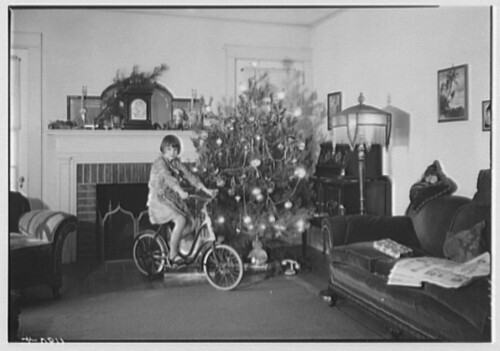
"Christmas of 1930" photograph from Library of Congress
Item Title-Christmas of 1930. Norma Horydczak on bicycle in front of Christmas tree, wide view.
Horydczak, Theodor, ca. 1890-1971, photographer.
Created/Published-1930.
Credit Line: Library of Congress, Prints & Photographs Division, Theodor Horydczak Collection, LC-H812-1190-004
Full record at this location.
Of course it was during the Depression. I guess she was lucky to get a bike at all.
Perhaps you have decided that you can't spring for a $6,000 copper-plated bicycle that isn't assembled and costs as much or more to have delivered ($250) as an OK occasional-use bike from a box-store - OK, fine, be that way. But Van Heesch has a copper-plated bell - surely you can afford a bell? Actually, perhaps you can't - the site says, "if you’re interested in purchasing a bell please write an email to info@vanheeschdesign.com." Presumably they then look you up in various sources and come up with "your special" price. Or decide you can't afford what they want for these bells and then ignore you?
Happy Holidays!!
Van Heesch has a channel in YouTube where they have videos of the $6,000 bike being used in different locales - here is Amsterdam
For good or bad, the metal portions of the bicycle are not made entirely of copper, rather it is a more regular sort of bike entirely plated in copper. There are lots of photos of the thing here. Don't want copper? Well, how about brass or perhaps zinc. (The possible appeal of zinc seems more than a little mysterious.)
None of this has to do with the traditional sort of Christmas "bicycle as gift" that I am familiar with, as shown in this photo from the Library of Congress ~

"Christmas of 1930" photograph from Library of Congress
Item Title-Christmas of 1930. Norma Horydczak on bicycle in front of Christmas tree, wide view.
Horydczak, Theodor, ca. 1890-1971, photographer.
Created/Published-1930.
Credit Line: Library of Congress, Prints & Photographs Division, Theodor Horydczak Collection, LC-H812-1190-004
Full record at this location.
Of course it was during the Depression. I guess she was lucky to get a bike at all.
Perhaps you have decided that you can't spring for a $6,000 copper-plated bicycle that isn't assembled and costs as much or more to have delivered ($250) as an OK occasional-use bike from a box-store - OK, fine, be that way. But Van Heesch has a copper-plated bell - surely you can afford a bell? Actually, perhaps you can't - the site says, "if you’re interested in purchasing a bell please write an email to info@vanheeschdesign.com." Presumably they then look you up in various sources and come up with "your special" price. Or decide you can't afford what they want for these bells and then ignore you?
Happy Holidays!!
Subscribe to:
Posts (Atom)